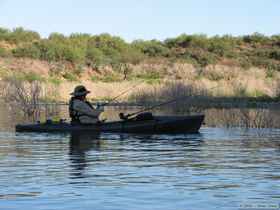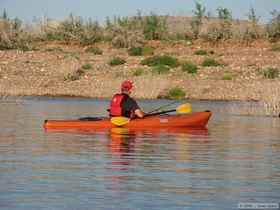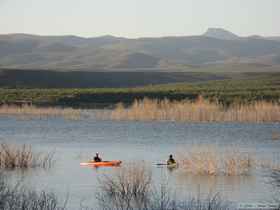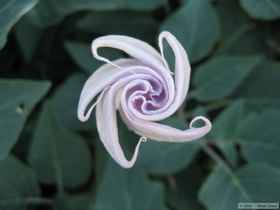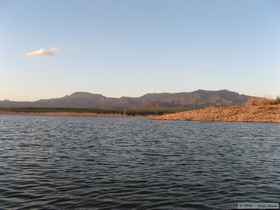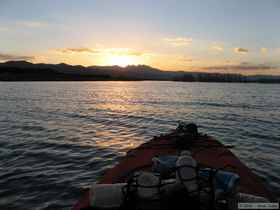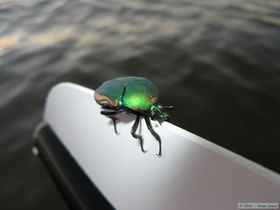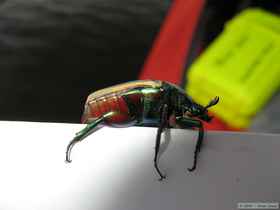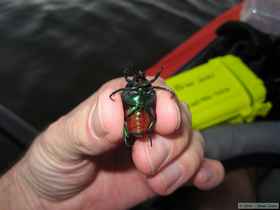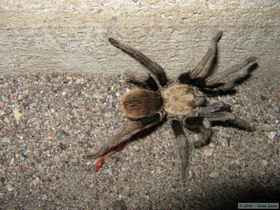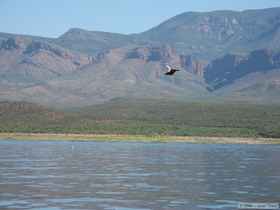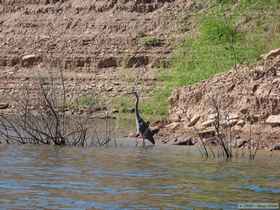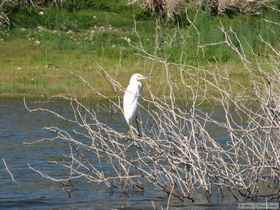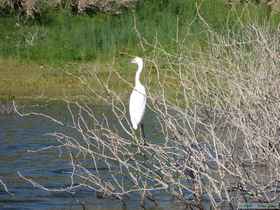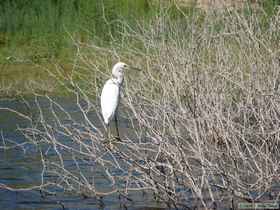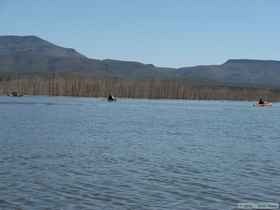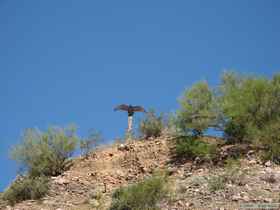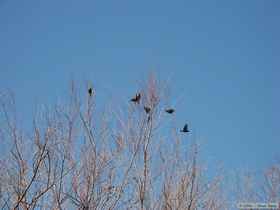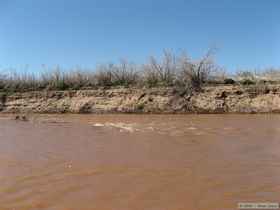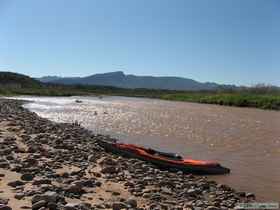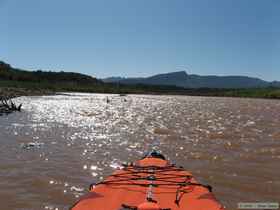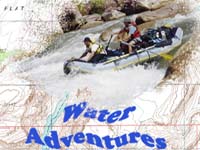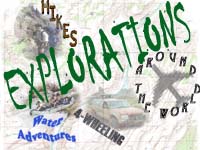Roosevelt Lake Kayaking/Camping Trip
September 2006
Added 27 September 2006
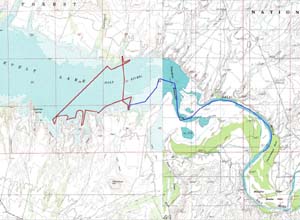 After his recent purchase of a new kayak, used primarily for fishing, my father-in-law fell in love with kayaking. He soon realized that he wanted to do something perhaps a bit more adventurous such as a weekend trip. This was enough of an excuse for me to try to plan something to satisfy his goal, not that I need any kind of excuse to plan a trip that gets me into anything even approximating the wilderness. My first thought was the White Mountains, but since Pat doesn't have any good cold-weather gear, even the White Mountains in mid-September was quickly ruled out as not being a likely option. Instead I turned to the desert lakes and the lakes up on the Mogollon Rim. Even there, I decided to leave the decision up to the weather.
After his recent purchase of a new kayak, used primarily for fishing, my father-in-law fell in love with kayaking. He soon realized that he wanted to do something perhaps a bit more adventurous such as a weekend trip. This was enough of an excuse for me to try to plan something to satisfy his goal, not that I need any kind of excuse to plan a trip that gets me into anything even approximating the wilderness. My first thought was the White Mountains, but since Pat doesn't have any good cold-weather gear, even the White Mountains in mid-September was quickly ruled out as not being a likely option. Instead I turned to the desert lakes and the lakes up on the Mogollon Rim. Even there, I decided to leave the decision up to the weather. 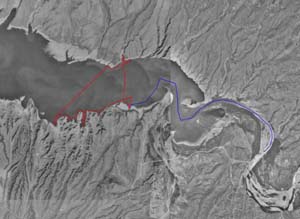 The rain-laden monsoon season hung on longer than usual and had left the north country a bit unseasonably cool, so the weather chose going to Lake Roosevelt.
The rain-laden monsoon season hung on longer than usual and had left the north country a bit unseasonably cool, so the weather chose going to Lake Roosevelt.
DAY 1
I took a Friday off, and dad and I joined Jeff at his house, where we all piled in to his truck with all our gear and three kayaks (my inflatable made the later somewhat easier to handle. We pulled into the Mesquite Loop of Schoolhouse Point campground at Roosevelt Lake (it's full name is Theodore Roosevelt Lake) at around noon. We had chosen the Schoolhouse Point area because it's at the far eastern end of the lake, and has many dead trees in the relatively shallow water. This serves to discourage what I call the "yahoo crowd," the folks zipping around in power boats and jet skis with a total disregard for those of us who prefer more serene modes of aquamotion.
A note for other would-be kayakers of Roosevelt Lake. We did this trip when the lake elevation was around 2,118 feet, with the lake 63% full. The flow in the Salt River was around 600 cfs.
The Mesquite Loop is the closest loop to the boat ramp, and was the only one open the weekend we went. There were only about a half dozen or so folks in the campground when we showed up, and there were only perhaps a dozen groups using the campground all weekend, which surprised me. I figured there would be a lot of folks there, but certainly wasn't upset to be wrong.
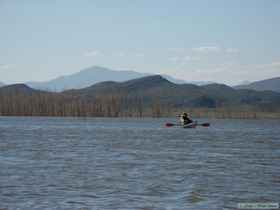
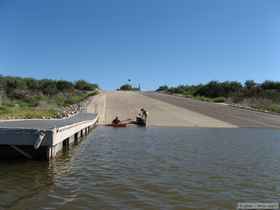 After setting up camp, we had lunch and relaxed under the ramada at the campsite for a while before hitting the water. It was pretty warm in the sun, but the shade and the breeze made the weather just about perfect. We decided to hit the water at around mid-afternoon. Jeff and Pat put their kayaks on rolling carts, and I carried mine to the water. It was the only time we'd end up doing that. It proved to be much faster and easier to drive them down to the boat ramp. Once on the water, we paddled east down the shore. Pat and Jeff quickly found a little cove where the fish were biting. I kayaked around the little cove for a while, checking things out and collecting trash, then headed further east along the shore. The sun was low in the sky by that point, and the surrounding mountains and hills were beautifully lit.
After setting up camp, we had lunch and relaxed under the ramada at the campsite for a while before hitting the water. It was pretty warm in the sun, but the shade and the breeze made the weather just about perfect. We decided to hit the water at around mid-afternoon. Jeff and Pat put their kayaks on rolling carts, and I carried mine to the water. It was the only time we'd end up doing that. It proved to be much faster and easier to drive them down to the boat ramp. Once on the water, we paddled east down the shore. Pat and Jeff quickly found a little cove where the fish were biting. I kayaked around the little cove for a while, checking things out and collecting trash, then headed further east along the shore. The sun was low in the sky by that point, and the surrounding mountains and hills were beautifully lit.
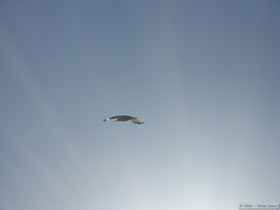
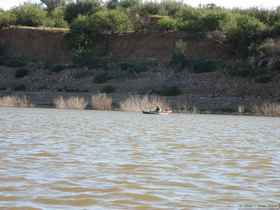 It seemed very incongruous to me, enjoying the desert from a kayak on a large lake. It was something that I couldn't entirely wrap my mind around. As I kayaked amongst long-dead willow trees whose tops stuck out of the water, I thought of the Salt River that once flowed past those trees. I wondered what else lay buried under the lake as well. That's not to say that I didn't enjoy being out on the water, just that my enjoyment was tempered somewhat by my Desert Ratness. To me, water in the desert is a sacred element. Water is to be found in what few rivers and creeks that have survived european settlement. The desert is thirsty, so water must move or die. But there I was, on a lot of water going nowhere but up, evaporating into thin air.
It seemed very incongruous to me, enjoying the desert from a kayak on a large lake. It was something that I couldn't entirely wrap my mind around. As I kayaked amongst long-dead willow trees whose tops stuck out of the water, I thought of the Salt River that once flowed past those trees. I wondered what else lay buried under the lake as well. That's not to say that I didn't enjoy being out on the water, just that my enjoyment was tempered somewhat by my Desert Ratness. To me, water in the desert is a sacred element. Water is to be found in what few rivers and creeks that have survived european settlement. The desert is thirsty, so water must move or die. But there I was, on a lot of water going nowhere but up, evaporating into thin air.
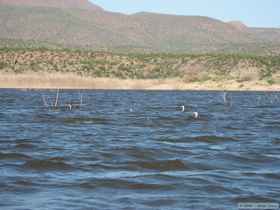
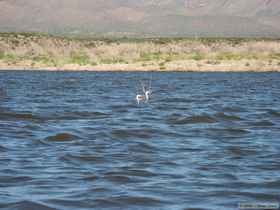 I tried to sidle up to some western grebes (Aechmophorus occidentalis), but they proved skittish, and I could never get very close to them. After exploring a while, I decided to check in on Pat and Jeff, so paddled up the shore, collecting trash along the way. Back at the cove, I found Jeff, but not Pat. As I paddled out of the cove to search for him, he was just paddling back after taking a break from sitting in the kayak. We both returned to the cove and I explored it some more while the two of them fished. I also got out of the kayak and wandered the shoreline for a little while. As the sun neared the horizon, I left the cove to enjoy a beautiful sunset.
I tried to sidle up to some western grebes (Aechmophorus occidentalis), but they proved skittish, and I could never get very close to them. After exploring a while, I decided to check in on Pat and Jeff, so paddled up the shore, collecting trash along the way. Back at the cove, I found Jeff, but not Pat. As I paddled out of the cove to search for him, he was just paddling back after taking a break from sitting in the kayak. We both returned to the cove and I explored it some more while the two of them fished. I also got out of the kayak and wandered the shoreline for a little while. As the sun neared the horizon, I left the cove to enjoy a beautiful sunset.
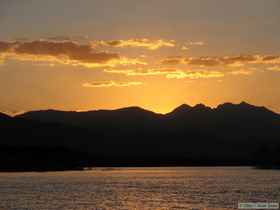 As I paddled back in, I saw in the distance what looked almost like a tiny frog swimming across the surface of the lake. I turned to investigate, and discovered that it wasn't a frog, but an amazingly beautiful green beetle.
As I paddled back in, I saw in the distance what looked almost like a tiny frog swimming across the surface of the lake. I turned to investigate, and discovered that it wasn't a frog, but an amazingly beautiful green beetle. 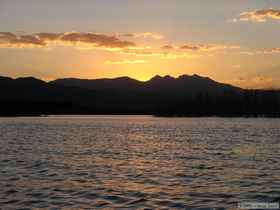 As he was hundreds of feet from shore, and was unlikely to make it on his own, I decided to give the little guy a second lease on life and fished him out of the drink with my paddle. I don't know if Davey Jones has a locker for insects, but he got one less victim if he does. We got back to the dock before we'd lost all of our light, and proceeded rolling or carrying our kayaks back to camp. We ended up putting my kayak on one of the kayak wheel sets and collective carrying the kayak Jeff was using. The steep boat ramp convinced us all that future trips to the water would be with the assistance of Jeff's truck.
As he was hundreds of feet from shore, and was unlikely to make it on his own, I decided to give the little guy a second lease on life and fished him out of the drink with my paddle. I don't know if Davey Jones has a locker for insects, but he got one less victim if he does. We got back to the dock before we'd lost all of our light, and proceeded rolling or carrying our kayaks back to camp. We ended up putting my kayak on one of the kayak wheel sets and collective carrying the kayak Jeff was using. The steep boat ramp convinced us all that future trips to the water would be with the assistance of Jeff's truck.
That evening we relaxed around the fire and waited for Chuck's arrival. Chuck rolled in to camp at around nine o'clock, and we stayed up until nearly midnight talking around the campfire.
Stats for Day 1: about 4 paddle miles
DAY 2
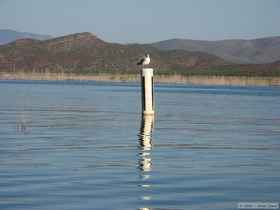 We were all awake with the sun the next morning, and after grabbing breakfast, we headed back out onto the water. This time, we started out heading west down the shoreline.
We were all awake with the sun the next morning, and after grabbing breakfast, we headed back out onto the water. This time, we started out heading west down the shoreline. 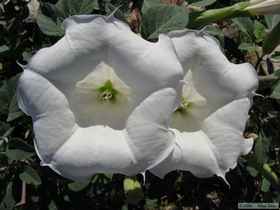 Pat expressed interest in paddling to the other side of the lake to an enticing cove we could see, but wasn't sure about paddling that far. It didn't look that far, so I decided to check it out. The other side of the lake proved to be more than a mile away based on my reckoning, which was borne out by looking at a map later. The red line on the maps at the top of this page is roughly the route I took that morning.
Pat expressed interest in paddling to the other side of the lake to an enticing cove we could see, but wasn't sure about paddling that far. It didn't look that far, so I decided to check it out. The other side of the lake proved to be more than a mile away based on my reckoning, which was borne out by looking at a map later. The red line on the maps at the top of this page is roughly the route I took that morning.
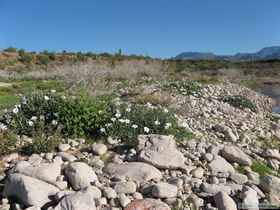 I explored the area a bit, but didn't want to abandon the group for too long, so quickly headed back to the southern shore.
I explored the area a bit, but didn't want to abandon the group for too long, so quickly headed back to the southern shore. 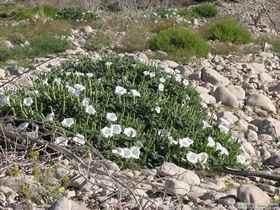 I returned at a diagonal towards the boat ramp at Grapevine, thinking that they would have continued up the shoreline and might be there. I couldn't find them there, so headed back towards Schoolhouse hugging the shoreline, exploring each cove as I went. I didn't find my companions in any of the coves, but I did find some great blue herons (Ardea herodias), and a beautiful snowy egret (Egretta thula). I also saw a belted kingfisher (Ceryle alcyon), which was cool.
I returned at a diagonal towards the boat ramp at Grapevine, thinking that they would have continued up the shoreline and might be there. I couldn't find them there, so headed back towards Schoolhouse hugging the shoreline, exploring each cove as I went. I didn't find my companions in any of the coves, but I did find some great blue herons (Ardea herodias), and a beautiful snowy egret (Egretta thula). I also saw a belted kingfisher (Ceryle alcyon), which was cool.
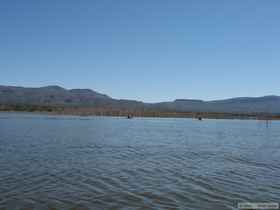 I was nearly back at Schoolhouse before I spotted Pat and Jeff, also heading east. It took me a while to catch up to them, and I did so just as Chuck reappeared from the east. We floated around the willows for a while, but since I'd paddled about 7 miles that morning, I didn't feel like going far, so Chuck and I decided to head back to shore and maybe cool off with a swim while Pat and Jeff continued to fish. Chuck and I ended up just hanging out at the dock watching all the people coming in and out of the boat ramp. Many had no idea what they were doing, so it was often comical.
I was nearly back at Schoolhouse before I spotted Pat and Jeff, also heading east. It took me a while to catch up to them, and I did so just as Chuck reappeared from the east. We floated around the willows for a while, but since I'd paddled about 7 miles that morning, I didn't feel like going far, so Chuck and I decided to head back to shore and maybe cool off with a swim while Pat and Jeff continued to fish. Chuck and I ended up just hanging out at the dock watching all the people coming in and out of the boat ramp. Many had no idea what they were doing, so it was often comical.
 After Pat and Jeff returned to the boat ramp, we loaded the kayaks up and went back to camp to eat lunch and enjoy some shade for the early afternoon. After hanging out for a while in camp, we headed back to the water. It was a windy afternoon, kicking up waves on the lake, but nothing too severe. The plan for the evening was to try to kayak all the way up to where the Salt River flows into Lake Roosevelt. The plan also included riding the wind on the way out, and paddling back after the wind had calmed down. We made it as far as the narrows when dad started feeling some pain from the back problem he'd been having. He decided to turn around and head back, so I did the same. Jeff and Chuck continued on a short ways before also turning around and heading back.
After Pat and Jeff returned to the boat ramp, we loaded the kayaks up and went back to camp to eat lunch and enjoy some shade for the early afternoon. After hanging out for a while in camp, we headed back to the water. It was a windy afternoon, kicking up waves on the lake, but nothing too severe. The plan for the evening was to try to kayak all the way up to where the Salt River flows into Lake Roosevelt. The plan also included riding the wind on the way out, and paddling back after the wind had calmed down. We made it as far as the narrows when dad started feeling some pain from the back problem he'd been having. He decided to turn around and head back, so I did the same. Jeff and Chuck continued on a short ways before also turning around and heading back.
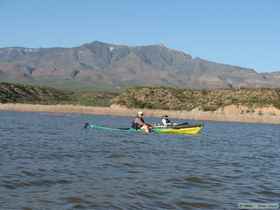 As we headed back, the wind hadn't died down at all, so we had to fight the wind and the waves. As Dad and I were crossing the open part of the lake, I was in the lead with Dad echeloned behind to my left. A moderate swell hit me broadside that I thought might make dad nervous, so I turned to warn him. I didn't really think it was enough to cause him any problems, but wanted to let him know it was coming and thought it would be a good demonstration of how stable his kayak was. I was wrong on a couple of counts . . . by the time I turned my head, all I saw was the bottom of his kayak. I quickly turned and by the time his head popped out of the water I was alongside to make sure he was alright.
As we headed back, the wind hadn't died down at all, so we had to fight the wind and the waves. As Dad and I were crossing the open part of the lake, I was in the lead with Dad echeloned behind to my left. A moderate swell hit me broadside that I thought might make dad nervous, so I turned to warn him. I didn't really think it was enough to cause him any problems, but wanted to let him know it was coming and thought it would be a good demonstration of how stable his kayak was. I was wrong on a couple of counts . . . by the time I turned my head, all I saw was the bottom of his kayak. I quickly turned and by the time his head popped out of the water I was alongside to make sure he was alright.
He appeared a little shaken, but in control, so we set about to figuring the best way to get him back in the boat. I had him hold on to my yak while I got his back upright again. The only casualty was the loss of his fishing pole. My first thought was to have him do a wet entry, but I ended up deciding it would probably be best to simply tow him and his yak to shore where we could more easily bail the yak out. He held on to the back of my kayak with one hand and the front of his water-laden kayak with the other, and I powered to shore. As I started paddling, I noticed Chuck in the distance away approaching us. I'd hoped to get to shore and get Pat back in his yak before Chuck was close enough to see what had happened, but paddling my yacht, a man in the water, and a drowned kayak proved much harder than I thought. By the time I got to shore, Chuck was fairly close.
Pulling in to shore, I had to nudge my kayak into the trees so that Dad and his boat would be in an area without trees to contend with. Once he was beached, I spun around and exited in the thigh deep water to help Pat get his feet under him in the waves crashing into the shore. Once he was upright, we got the boat on shore and worked at bailing it out. Once Chuck arrived, the two of us simply lifted the kayak up and dumped the water out that way. By the time that was done, Jeff was there too. With that bit of excitement over, Dad got back in the kayak and we continued on to the boat ramp.
Once we got the boats loaded up, I decided that a bath might be in order so stayed behind and took a little swim in the lake before walking back to camp. Back at camp we had dinner and enjoyed another night talking around the camp fire. 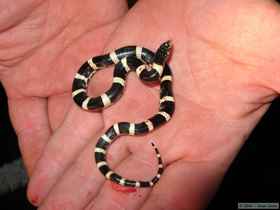 Jeff decided to back down the the boat ramp for a little night fishing, and later, Chuck and I decided to drive the roads near the campground in search of snakes. Chuck, amazingly, spotted a small king snake on the road after we left the campground. Chuck caught him and got bit before the snake calmed down. We took him back to camp to show Pat, and continued our search.
Jeff decided to back down the the boat ramp for a little night fishing, and later, Chuck and I decided to drive the roads near the campground in search of snakes. Chuck, amazingly, spotted a small king snake on the road after we left the campground. Chuck caught him and got bit before the snake calmed down. We took him back to camp to show Pat, and continued our search.  We didn't see anymore snakes, but we did see a barn owl, the first that either Chuck or I had seen in the wild, so that was cool. There weren't too many small roads to travel, so it wasn't long before we were back in camp showing Dad the king snake. The three of us then walked a short ways from camp to release the king snake in the desert.
We didn't see anymore snakes, but we did see a barn owl, the first that either Chuck or I had seen in the wild, so that was cool. There weren't too many small roads to travel, so it wasn't long before we were back in camp showing Dad the king snake. The three of us then walked a short ways from camp to release the king snake in the desert.
We sat by the fire talking, and before long, Jeff returned from his night fishing experience. Apparently his beginners luck had worn off, for he didn't catch anything. Eventually Dad went to bed, but the rest of us stayed up and talked until late in the night. By the end of the night, the talk turned philosophical, touching on the age of the earth, spirituality, religion, and higher beings. Gotta love campfire talk!
Stats for Day 2: about 12 paddle miles
DAY 3
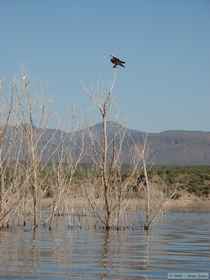 The next morning, Chuck decided to leave early to visit his dad in nearby Punkin Center (yes, that's a real name of a real town) as the rest of us hit the water.
The next morning, Chuck decided to leave early to visit his dad in nearby Punkin Center (yes, that's a real name of a real town) as the rest of us hit the water. 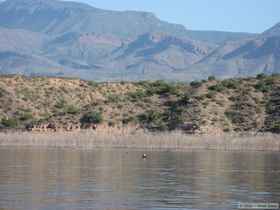 Jeff and Dad did some more fishing, and I decided to try one more time to reach the Salt River. Before getting to the narrows, I happened upon an osprey (Pandion haliaetus) with a fish in it had caught. After flying away, it did what I thought was a strange thing, and landed on something that was completely underwater. About a third of the osprey was underwater while it sat on the perch.
Jeff and Dad did some more fishing, and I decided to try one more time to reach the Salt River. Before getting to the narrows, I happened upon an osprey (Pandion haliaetus) with a fish in it had caught. After flying away, it did what I thought was a strange thing, and landed on something that was completely underwater. About a third of the osprey was underwater while it sat on the perch. 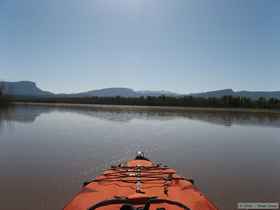 I paddled on, watching the osprey as it moved, as well as great blue herons and other birds, including a turkey vulture sunning itself. As I paddled, I kept searching intently, expecting something extremely exciting to appear, such as a creature that doesn't even exist in the United States. As Chuck had noted earlier, our trip to the Pantanal and Amazon in Brazil a few months prior to this trip had greatly heightened our expectations for what to find while floating on a body of water.
I paddled on, watching the osprey as it moved, as well as great blue herons and other birds, including a turkey vulture sunning itself. As I paddled, I kept searching intently, expecting something extremely exciting to appear, such as a creature that doesn't even exist in the United States. As Chuck had noted earlier, our trip to the Pantanal and Amazon in Brazil a few months prior to this trip had greatly heightened our expectations for what to find while floating on a body of water.
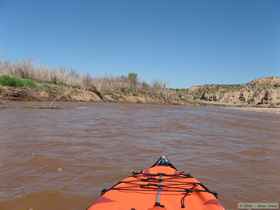 After paddling about five miles from Schoolhouse Point, I finally reached the river. When it got to the point where it became too inefficient to paddle upstream, I got out and pulled the boat upstream.
After paddling about five miles from Schoolhouse Point, I finally reached the river. When it got to the point where it became too inefficient to paddle upstream, I got out and pulled the boat upstream.  For some inexplicable reason, I wanted to float down at least some portion of the Salt River before returning home. And of course, I also wanted to experience the thrill of kayaking down the Class (cough!) V rapid I found. Yes, that's right, a Class (cough!) V rapid! Ok, ok, so it was a class point-five rapid. That morning, the Salt was flowing at around 547 cubic feet per second (cfs), or about 193% of normal (294 cfs) for September 17th. You can get daily and historical water reports for Roosevelt Lake, the Salt River, and others at http://www.srpwater.com/dwr/. Sometime, I'd maybe like to try floating down the Salt into Roosevelt Lake.
For some inexplicable reason, I wanted to float down at least some portion of the Salt River before returning home. And of course, I also wanted to experience the thrill of kayaking down the Class (cough!) V rapid I found. Yes, that's right, a Class (cough!) V rapid! Ok, ok, so it was a class point-five rapid. That morning, the Salt was flowing at around 547 cubic feet per second (cfs), or about 193% of normal (294 cfs) for September 17th. You can get daily and historical water reports for Roosevelt Lake, the Salt River, and others at http://www.srpwater.com/dwr/. Sometime, I'd maybe like to try floating down the Salt into Roosevelt Lake.
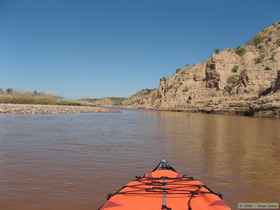
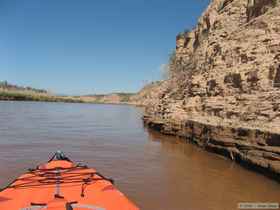 I've piloted rafts through Class IV+ rapids, and actually have no desire to do anything close to that level in a kayak, and certainly not in my Advanced Elements inflatable kayak. Anyway, after my bit of "excitement," I started the long paddle back to camp.
I've piloted rafts through Class IV+ rapids, and actually have no desire to do anything close to that level in a kayak, and certainly not in my Advanced Elements inflatable kayak. Anyway, after my bit of "excitement," I started the long paddle back to camp.
I found Jeff near the cove by the boat ramp, and Dad had just made it back to the ramp when I got to Jeff. By this time, it was nearly noon, so Jeff and I paddled in to the ramp and got our yaks back to camp for lunch before packing up and heading home. The blue line on the maps at the top of this page is roughly the route I took that morning.
Stats for Day 3: about 10 paddle miles
Though I can't say that Lake Roosevelt is my favorite place to paddle, it's convenient location and some good company can turn it into a pleasant weekend outing.
 After his recent purchase of a new kayak, used primarily for fishing, my father-in-law fell in love with kayaking. He soon realized that he wanted to do something perhaps a bit more adventurous such as a weekend trip. This was enough of an excuse for me to try to plan something to satisfy his goal, not that I need any kind of excuse to plan a trip that gets me into anything even approximating the wilderness. My first thought was the White Mountains, but since Pat doesn't have any good cold-weather gear, even the White Mountains in mid-September was quickly ruled out as not being a likely option. Instead I turned to the desert lakes and the lakes up on the Mogollon Rim. Even there, I decided to leave the decision up to the weather.
After his recent purchase of a new kayak, used primarily for fishing, my father-in-law fell in love with kayaking. He soon realized that he wanted to do something perhaps a bit more adventurous such as a weekend trip. This was enough of an excuse for me to try to plan something to satisfy his goal, not that I need any kind of excuse to plan a trip that gets me into anything even approximating the wilderness. My first thought was the White Mountains, but since Pat doesn't have any good cold-weather gear, even the White Mountains in mid-September was quickly ruled out as not being a likely option. Instead I turned to the desert lakes and the lakes up on the Mogollon Rim. Even there, I decided to leave the decision up to the weather.  The rain-laden monsoon season hung on longer than usual and had left the north country a bit unseasonably cool, so the weather chose going to Lake Roosevelt.
The rain-laden monsoon season hung on longer than usual and had left the north country a bit unseasonably cool, so the weather chose going to Lake Roosevelt.






